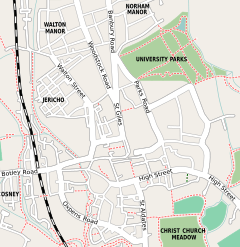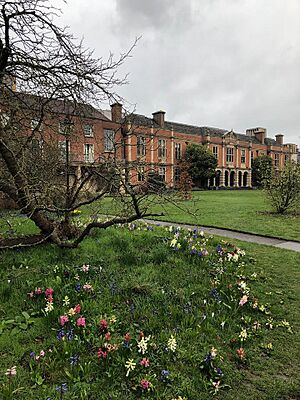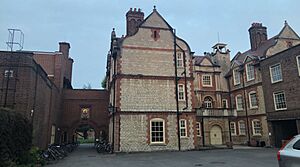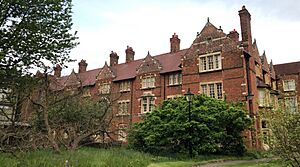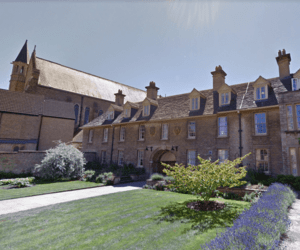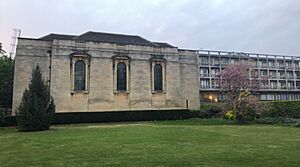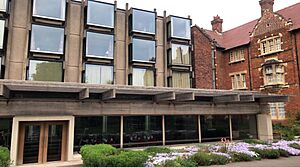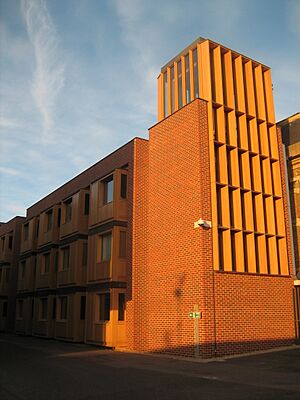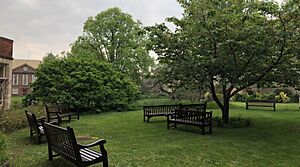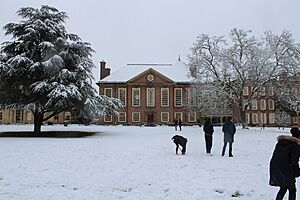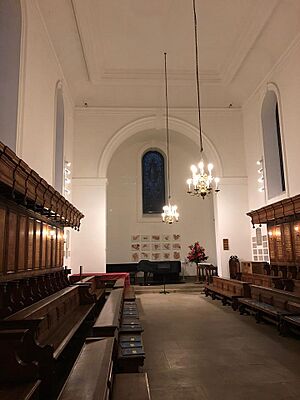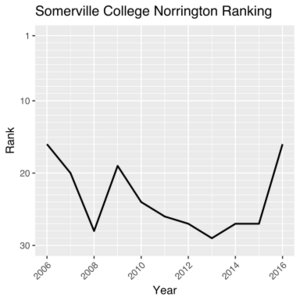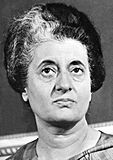Somerville College, Oxford facts for kids
Quick facts for kids Somerville College |
||||||||||||||||||
|---|---|---|---|---|---|---|---|---|---|---|---|---|---|---|---|---|---|---|
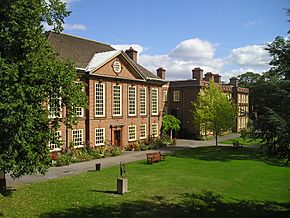
Somerville College Hall
|
||||||||||||||||||
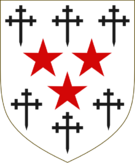
Blazon: Argent, three mullets in chevron reversed gules, between six crosses crosslet fitched sable
|
||||||||||||||||||
|
|
||||||||||||||||||
| University | University of Oxford | |||||||||||||||||
| Location | Woodstock Road, Oxford OX2 6HD | |||||||||||||||||
| Coordinates | 51°45′33″N 1°15′45″W / 51.75917°N 1.26250°W | |||||||||||||||||
| Full name | Somerville College in the University of Oxford | |||||||||||||||||
| Latin name | Collegium de Somerville | |||||||||||||||||
| Motto | Donec rursus impleat orbem (translated: Until it should fill the world again) |
|||||||||||||||||
| Established | 1879 | |||||||||||||||||
| Named for | Mary Somerville | |||||||||||||||||
| Previous names | Somerville Hall (1879–1894) | |||||||||||||||||
| Colours | ||||||||||||||||||
| Sister college | Girton College, Cambridge | |||||||||||||||||
| Principal | Baroness Royall of Blaisdon | |||||||||||||||||
| Undergraduates | 437 (2020–21) | |||||||||||||||||
| Postgraduates | 235 | |||||||||||||||||
| Boat club | Somerville College Boat Club | |||||||||||||||||
| Map | ||||||||||||||||||
Somerville College is a part of the University of Oxford in England. It was started in 1879 as Somerville Hall, one of Oxford's first colleges for women. Men began to be admitted in 1994. The college was founded by people who believed in social freedom, making it Oxford's first college for women that didn't require students to belong to a specific religion. This was different from Lady Margaret Hall, another women's college that opened the same year, which was linked to the Anglican Church.
In 1964, Somerville was one of the first colleges to stop locking its gates at night. This meant students could stay out later. Also, students do not wear special academic gowns at formal dinners here.
In 2021, Somerville College was recognized as a "sanctuary campus." This means it welcomes and supports students who are seeking safety. It is one of only three Oxford colleges that lets undergraduate students live on campus for their entire course. The college is located near the Science Area, University Parks, and other Oxford colleges. More than a third of its 650 students are from outside the UK. Also, over half of its UK students come from state schools, which is similar to the university average. Its total net assets in 2021 were £238 million, making it one of the wealthiest Oxford undergraduate colleges. Its sister college at Cambridge is Girton.
Many famous people have studied at Somerville College. These include Margaret Thatcher, who became Prime Minister, Indira Gandhi, who became Prime Minister of India, and Nobel Prize winner Dorothy Hodgkin. Other notable alumni include writers Iris Murdoch and Dorothy L. Sayers.
Contents
- College History: How Somerville Began
- The Mutual Admiration Society
- College Buildings and Grounds
- Walton House: The First Building
- Park Building
- The College Library
- Hall and Maitland Buildings
- Penrose Building
- Darbishire Quadrangle
- Chapel
- Hostel and Holtby Buildings
- Vaughan and Margery Fry & Elizabeth Nuffield House
- Wolfson Building
- Margaret Thatcher Centre and Dorothy Hodgkin Quadrangle
- St Paul's Nursery
- Radcliffe Observatory Quarter Buildings
- The Terrace
- Catherine Hughes Building
- College Gardens
- Student Life at Somerville
- University Challenge Success
- Somerville's Links to India
- People Connected to Somerville
- College Symbols: Arms and Motto
- See also
College History: How Somerville Began
Founding a New College
In June 1878, a group called the Association for the Higher Education of Women was formed. Their goal was to create a college for women in Oxford. Some important members were George Granville Bradley and T. H. Green. Another member, Edward Stuart Talbot, wanted a college specifically for the Anglican Church. This idea did not suit most other members.
So, the group split. Talbot's group founded Lady Margaret Hall, which opened in 1879. The other group, known as the "Balliol camp," wanted a college that welcomed students of all religions. This group had strong ties to the Liberal Party. Key members included John Percival and Mary Augusta Ward.
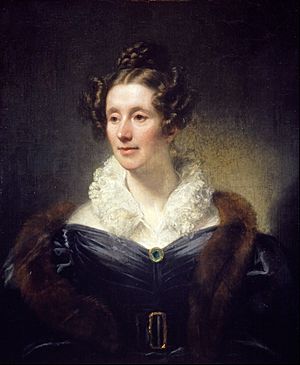
This second group founded Somerville Hall in 1879. It was named after Mary Somerville, a Scottish mathematician and science writer who had recently passed away. The founders chose her name because it represented the college's values of freedom and academic success. Mary Somerville was admired for her scholarship and her belief in equal rights for women, including their right to vote and to get an education.
Madeleine Shaw-Lefevre was chosen as the first head of the college. Even though she wasn't a famous academic, her background matched the college's open-minded approach. Because it was a college for women and didn't have religious rules, Somerville was seen by some in Oxford as a bit unusual.
Becoming a Women's College
When Somerville Hall opened, it had twelve students, aged 17 to 36. The first students from Somerville and Lady Margaret Hall attended classes in rooms above a bakery. Only two of the original twelve students stayed for three years, which was the usual time for men to complete a degree.
Over time, Somerville became more organized. In 1882, it hired its first in-house tutor. By the late 1890s, women students could attend lectures at almost all Oxford colleges. In 1891, Somerville was the first women's hall to introduce entrance exams. In 1894, it became the first of the five women's halls to be called a "college." It also hired its own teachers and built its own library. Soon, it became known as the "bluestocking college" because its excellent exam results proved that women could achieve high academic success.
In the 1910s, Somerville was known for supporting the women's right to vote. In 1920, Oxford University finally allowed women to officially enroll and earn degrees. In the early days, female students had to be accompanied by a chaperone when with male students. This rule was removed in 1925, though male visitors still had a curfew. In the same year, the college received its official charter.
The Mutual Admiration Society
The Mutual Admiration Society (MAS) was a group of women writers who became friends at Somerville College. Members included Dorothy L. Sayers, Muriel St Clare Byrne, and others.
This society was a real club where members wrote poetry and stories for each other. While Dorothy L. Sayers became very famous, the other members were also notable. A book by Mo Moulton called The Mutual Admiration Society: How Dorothy L. Sayers and Her Oxford Circle Remade the World For Women argues that each member lived a life worth remembering.
Years later, writer Vera Brittain, who was at Somerville at the same time but not in the group, said that the MAS "took themselves very seriously."
Somerville During World War I
During the First World War, Somerville College and other Oxford buildings were used as a military hospital. This hospital treated soldiers who were injured in the war. For this time, Somerville students moved to Oriel College. Because many male students had joined the military, Somerville was able to rent a part of Oriel College. They built a wall to separate it from the remaining male students. Many students and teachers from Somerville helped with war efforts, and some even went to the Western Front in France.
Famous patients who stayed at Somerville included war poets Robert Graves and Siegfried Sassoon. Sassoon arrived on August 2, 1916. Graves and Sassoon later remembered their time at Somerville Hospital fondly. Graves wrote, "I enjoyed my stay at Somerville. The sun shone, and the discipline was easy."
After the war ended, it took some time for things to return to normal. In 1919, male students made a hole in the wall separating the sexes in an event known as the "Oriel raid." In July 1919, the principal and fellows returned to Somerville. Alumna Vera Brittain wrote about the war's impact on Oxford in her memoir Testament of Youth.
Admitting Men to Somerville
Starting in the 1970s, Oxford colleges that had only admitted men began to accept women. This put pressure on women-only colleges like Somerville to also become mixed. It was thought that having a wider range of students would lead to better academic results. Women's colleges found it harder to attract good applicants and their academic rankings dropped.
There was a lot of discussion in the 1980s about whether women's colleges should become mixed. Somerville remained a women's college until 1992. That year, its rules were changed to allow male students and teachers. The first male teachers were hired in 1993, and the first male students were admitted in 1994. Somerville was the second-to-last college (after St Hilda's) to become coeducational. Since then, the college has aimed for an equal number of male and female students.
In the 1890s Somerville helped fashion the "New Woman"; a century later... the college has set itself the perhaps greater challenge of educating the "New Man."
College Buildings and Grounds
Somerville College is located on Woodstock Road. Its main entrance is called the Porters' Lodge. The college has buildings in many different styles, often named after former principals. These buildings are arranged around one of Oxford's largest main courtyards, called a quad. Five of its buildings are listed as Grade II, meaning they are historically important.
Archaeological studies in 2017 showed that in medieval times, the area where Somerville now stands was open fields outside Oxford. There is also evidence of 17th-century buildings and earthworks. Some of these likely relate to the defenses built around the city during the Civil War. Remains of 19th-century buildings, including a stone well, were also found.
Walton House: The First Building
The very first building of Somerville Hall was Walton House, built in 1826. It was bought in 1880. This house could only fit seven of the first twelve students. In 1881, a new south wing was added to fit eleven more students. Later, a north wing and an extra floor were added. A gatehouse was also built at the Woodstock Road entrance.
Today, Walton House, often called House, has only one or two student rooms. It used to have the college bar until 2014. It also contains Green Hall, where visitors are welcomed. Most of the college's administration offices are in House. The Mary Somerville Room, a reception room, features paintings of Mary Somerville.
Park Building
The idea for a second self-contained building was inspired by Newnham College, Cambridge. This building, now called Park, was designed by Harry Wilkinson Moore. It was built in two stages. The first stage (1885–1887) created rooms for 18 students, with their own dining room and sitting rooms. This was meant to feel like a family home for the women students. The second stage (1888–1894) added more rooms for students and teachers. In 2004, it was renamed Park in honor of Daphne Park, who was Principal from 1980 to 1989.
Today, Park has over 60 rooms for students and teachers. It also has a music room and a computer room. Park is a Grade II-listed building.
The College Library
The college library, designed by Basil Champneys in 1903, is a Grade II-listed building. It was opened in 1904. This was the first library built specifically for women's colleges at Oxford. It was designed to hold 60,000 books, even though the college only had 6,000 when it opened. Now, it holds about 120,000 items, making it one of the largest college libraries in the university.
Many important people have given books to the library, including Amelia Edwards and John Stuart Mill. It also has paintings by Mary Somerville and John Constable. The John Stuart Mill room contains his personal library, with notes in many of the books.
The library is a central part of the main quadrangle. It is open 24 hours a day and offers Wi-Fi, a group study room, and computers. Students often say they are very happy with the library in surveys.
Hall and Maitland Buildings
Before 1911, there was no hall big enough for all the students to eat together. That year, Maitland Hall and Maitland building were opened. They were designed by Edmund Fisher. A special fund was raised to honor Agnes Catherine Maitland, who was Principal from 1889 to 1906. This money was used to pay for the oak wood panels in the Hall. The panels on the south wall were designed to frame a portrait of Mary Somerville.
These buildings are now on the east side of the main quad. They are Grade II-listed. The Senior Common Room, for teachers, is on the ground floor. The first floor holds the pantry and the main hall, where formal dinners are held weekly.
Maitland building now has few student rooms. It is mainly used for teachers' offices. It is named after former Principal Agnes Maitland.
Penrose Building
The Penrose building was designed in 1925 and students moved in during 1927. It was built on the site of old houses on Walton Street. In 2014, it was updated with new carpets and furniture. Penrose is named after Dame Emily Penrose, who was the third Principal of the college. It mainly provides rooms for first-year students, with about 30 rooms.
Darbishire Quadrangle
Darbishire Quad was part of a plan to use properties along Woodstock Road. In the 1920s, the college bought several houses and a pub. These buildings were taken down in 1932–1933.
A new quadrangle was built in their place. This new area included the porters' lodge and a new Council Room. It provided rooms for students and teachers. The college's coat of arms and symbols of its founders were carved inside the quad. An archway leading to the Hall was added in 1938.
This area was first called the East Quadrangle. It was opened in June 1934. In 1962, it was renamed Darbishire in honor of Helen Darbishire, who was the college's principal during its construction.
Today, Darbishire has about 50 student rooms, along with teachers' offices and the college archives. The offices of the Global Ocean Commission were located here from 2012 to 2016.
Darbishire Quad is mentioned in the book Gaudy Night by alumna Dorothy L. Sayers. The clock in the quad was given by alumna Eleanor Rathbone.
Chapel
The Somerville Chapel was built mostly with money from alumna Emily Georgiana Kemp in 1935. It shows the college's founding principle of not being tied to one religion. No religious tests were used for admission, and Christian prayers were said in the college.
Instead of a chaplain, there is a "Chapel Director," keeping with its non-religious tradition. The chapel offers Christian worship and also hosts speakers from many different religious backgrounds. It has an excellent mixed-voice Choir, which travels and releases recordings.
Hostel and Holtby Buildings
Hostel is a small building completed in 1950. It has 10 student rooms on three floors. The Bursary, which handles college finances, is on the ground floor.
Holtby was designed in 1951 and finished in 1956. It is located above the library extension. It has ten rooms for undergraduate students and is named after alumna Winifred Holtby.
Vaughan and Margery Fry & Elizabeth Nuffield House
These buildings, designed by Sir Philip Dowson, were built between 1958 and 1966. They are named after former principals of the college, Janet Vaughan and Margery Fry. Elizabeth Nuffield was also important for supporting women's education. Margery Fry was opened in 1964, and Vaughan in 1966. They have a similar modern style, with an outer concrete frame.
Vaughan is the larger building, with about 60 undergraduate rooms. These rooms are mainly for first-year students. Vaughan was updated in 2013 with new bathrooms. A tunnel under these buildings provides access to Somerville from Little Clarendon Street.
Margery Fry is the main center for postgraduate students at Somerville, with 24 graduate rooms. Other housing for graduate students is available in buildings near the college.
Wolfson Building
The Wolfson building was designed by Sir Philip Dowson to house students and offices for teachers. It is made mostly of glass and concrete and is also Grade II listed. This four-story building offers views of Walton Street and Somerville's main quad. Wolfson is named after its main supporter, Sir Isaac Wolfson. It was opened in 1967.
The ground floor has the Flora Anderson Hall (FAH) and the Brittain-Williams Room. This room is named after Vera Brittain and Shirley Williams, a famous mother-daughter pair who studied at the college. The FAH is used for lectures, events, and college parties.
Margaret Thatcher Centre and Dorothy Hodgkin Quadrangle
The Margaret Thatcher Centre (MTC) is named after the alumna who became Prime Minister. It includes a lecture room, a waiting area, and a lobby used for meetings and events. The lecture room has full audio-visual equipment and seats 60 people. A statue of Margaret Thatcher is in the lobby. The meeting room has portraits of Somerville's two Prime Minister alumni: Margaret Thatcher and Indira Gandhi.
The Dorothy Hodgkin Quad (DHQ) was planned in 1985 and finished in 1991. It is named after Somerville's Nobel Prize winner, Dorothy Hodgkin. This quadrangle has self-contained apartments with two or four bedrooms and shared kitchens. It mainly houses students in their final year and some second-year students.
The buildings were opened in 1991 by Margaret Thatcher, Dorothy Hodgkin, and other important figures.
St Paul's Nursery
Somerville College was the first Oxford college to provide a nursery for the children of its teachers and staff. It is still one of the few colleges to do so. Alumna Dorothy Hodgkin donated much of her Nobel Prize money to this project. St Paul's Nursery is also open to families not connected to the college. It cares for 16 children aged three months to five years.
Radcliffe Observatory Quarter Buildings
ROQ East and West are new buildings completed in 2011. They were the first new buildings in the university's Radcliffe Observatory Quarter. They have won several awards for their design. These buildings house 68 students in rooms with private bathrooms. They also have features to help students with disabilities, like lifts and connecting carer rooms. The buildings were funded by donations from alumni and friends. They offer a clear view of the Radcliffe Observatory.
The Terrace
The college's bar and café, The Terrace, opened in 2013. It replaced the old bar in House. It is mostly made of glass and has seating in the college colors of red and black. It has an outdoor terrace overlooking Little Clarendon Street. The Terrace has a pool table and serves drinks, including the college's special drink, "Stone-cold Jane Austen."
Catherine Hughes Building
Named after Somerville's former principal, Catherine Hughes, this building was finished in October 2019. It provides 68 additional bedrooms with private bathrooms and kitchens. It also has a new study area for graduate students.
The red-brick building faces Walton Street and can also be accessed from the college gardens. Its construction means Somerville is one of three Oxford colleges that can offer all students starting from 2017 a place to live in college for their entire undergraduate degree.
College Gardens
Somerville is one of the few Oxford colleges where students are allowed to walk on the grass. The college has a large green space cared for by two gardeners. The original site had a paddock, an orchard, and a vegetable garden. During World War I, the paddock became tennis courts. In World War II, large water tanks were dug in the main quads in case of fire, and the lawns were used to grow vegetables.
In the Main or Library Quad, there is a cedar tree planted by Harold Macmillan in 1976. Another tree, a Picea likiangensis, was planted in 2007 on the chapel lawn, serving as an outdoor Christmas tree. The lavender and Agapanthus plants near the library refer to Somerville's "bluestocking" reputation. The blue Ceratostigma willmottianum plant stands outside the Margaret Thatcher Centre.
There are also links to India in the gardens, like a large Indian horse chestnut tree planted in 2019. Other interesting features include a narrow bed of Mediterranean plants, various mature trees, and large flower borders with thistles, which are a symbol of Somerville.
The seasonal flowers in Darbishire Quad and other areas have traditionally been in a Victorian style, reflecting the college's founding era. However, this is changing to be more environmentally friendly. The Fellows' Garden, a secluded area, has a sundial from 1926 that honors the first principal, Madeleine Shaw-Lefevre.
In 1962, artist Henry Moore lent his sculpture Falling Warrior to the college. There are also permanent sculptures by Wendy Taylor, Friedrich Werthmann, and Somervillian Polly Ionides. The most striking sculpture is Taylor's Triad (1971), located on the Chapel Lawn.
Student Life at Somerville
In 2011, student satisfaction at Somerville was rated among the highest in the university. The large main quad is a central part of student life and is often filled with students in summer. Somerville is one of the few Oxford colleges where students can walk on the grass. The college is sometimes called The Ville. Formal dinners happen about six times a term. Students do not wear gowns, and a short prayer is said. The college song is Omnes laetae nunc sodales.
Sports and Activities
Somerville has a gym with exercise machines and weights. It shares a sports ground with Wadham College and St Hugh's College. There are many sports clubs and teams, including football, rugby, lacrosse, cricket, swimming, hockey, netball, and more.
The Somerville cricket and netball teams won their university competitions in 2014/15. The swimming team won in 2015/16.
Rowing at Somerville
Somerville started a rowing team in 1921. It competes in the annual university rowing races, Torpids and Summer Eights. The women's team is the most successful women's rowing team at the university. They have won the "Head of the River" title eight times in Summer Eights and five times in Torpids. The club shares a boathouse on The Isis river with other colleges.
College Choir
The Somerville College Choir has mixed voices and is led by the Director of Chapel Music. The choir is very important to the college's musical life.
They perform regular concerts and visit cathedrals. In recent years, the choir has toured Germany, Italy, and the United States. They sing every Sunday evening during term time. The college chapel has an organ built by Harrison & Harrison.
Somerville offers up to eight Choral Exhibitions each year to students who sing well. The choir has released two music CDs.
Triennial Ball
Every three years, Somerville hosts a large ball with Jesus College, Oxford. The last one was in April 2022, and the next will be in 2025.
The 2013 ball, called The Last Ball, had some problems. The organizers had planned to display a live nurse shark, but this was stopped after student protests. The ball was also criticized for being poorly organized, with not enough food and other issues.
Academic Performance
Before men were admitted, Somerville often ranked at or near the top of the Norrington Table. This table lists Oxford colleges based on their students' exam results. Currently, Somerville is in the lower half of the university's colleges for academic achievement. For the 2018/19 academic year, it ranked 21st out of 30 colleges. The college has been recognized as a University College of Sanctuary and offers scholarships for students seeking safety.
University Challenge Success
Somerville has done very well on the TV quiz show University Challenge for its size. It won the competition once in the University Challenge 2001–02 series. The college team also reached the final of the University Challenge 2013–14 series.
Somerville's Links to India
Somerville College has strong connections with India. Cornelia Sorabji, born in British India, was the first Indian woman to study at any British university when she came to Somerville in 1889 to study law. Indira Gandhi, India's first female prime minister, studied Modern History at the college in 1937. Other Indian alumni include Radhabai Subbarayan, the first woman member of the Indian Council of States.
Sonia Gandhi visited Somerville in 2002 and gave a portrait of her late mother-in-law, Indira Gandhi, to the college. Indira Gandhi received an honorary degree from the college in 1971.
In 2012, the college and Oxford University announced a plan for a center focused on sustainable development in India. This center, now called the Oxford India Centre for Sustainable Development (OICSD), conducts research and provides scholarships for Indian students. The center now hosts 12 India scholars.
In 2018, Somerville's choir was the first Oxford college choir to tour India.
People Connected to Somerville
Famous Alumni
People who have studied at Somerville, called Somervillians, include Prime Ministers Margaret Thatcher and Indira Gandhi. Other notable alumni are Nobel Prize-winning scientist Dorothy Hodgkin, TV personalities Esther Rantzen and Susie Dent, and writers like Vera Brittain and Iris Murdoch.
Somerville alumni have achieved many "firsts." These include the first woman Prime Minister of the United Kingdom (Margaret Thatcher) and the first British woman to win a Nobel Prize in science (Dorothy Hodgkin). Indira Gandhi was the first woman to lead India, the world's largest democracy.
Somerville has educated at least 29 Dames, 18 heads of Oxford colleges, 11 members of the House of Lords, 11 Members of Parliament, and two prime ministers.
Former students of Somerville belong to an alumni group called the Somerville Association, which started in 1888.
Notable Fellows
Important teachers and researchers at Somerville College (who were not alumni) include philosopher G. E. M. Anscombe, biochemist Louise Johnson, and classicists Edith Hall and Lotte Labowsky. Other fellows include author Alan Hollinghurst and astronomer Chris Lintott.
College Principals
The first head of Somerville Hall was Madeleine Shaw-Lefèvre (1879–1889). When it became Somerville College in 1894, Agnes Catherine Maitland (1889–1906) became the first Principal. She was followed by classical scholar Emily Penrose (1906–1926), who started a research fellowship for women in Oxford.
The current principal is Janet Royall, Baroness Royall of Blaisdon. She took on the role in August 2017. So far, seven principals have been alumni of Somerville, and two have been from St Hilda's College.
College Symbols: Arms and Motto
Like all Oxford colleges, Somerville has special symbols and colors. The college colors are red and black, which appear on the college scarf and on the blades of its rowing boats. These colors were first used in the 1890s. The college flag shows its shield on a yellow background.
The college's coat of arms also uses red and black. It shows three stars in a reversed V-shape, with six small crosses. The college's motto, Donec rursus impleat orbem, was originally the motto of Mary Somerville's family. Her family supported the new college, allowing it to use their arms and motto. The Latin motto means "Until It Should Fill the World Again." It is considered a bit mysterious because it doesn't say what "it" refers to.
See also
 In Spanish: Somerville College para niños
In Spanish: Somerville College para niños


